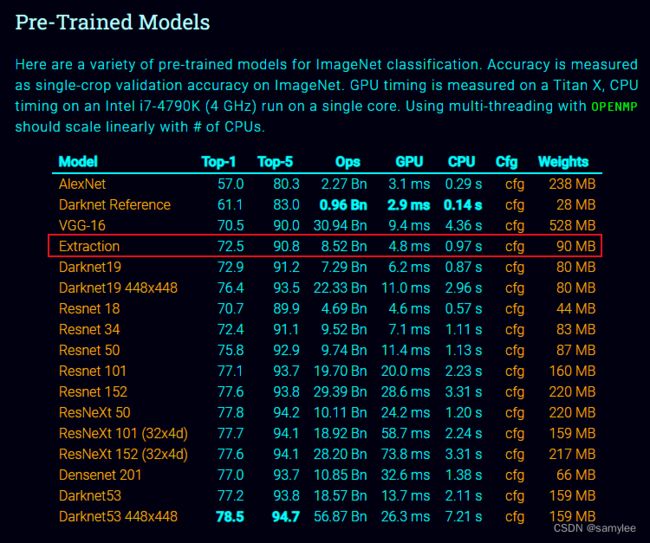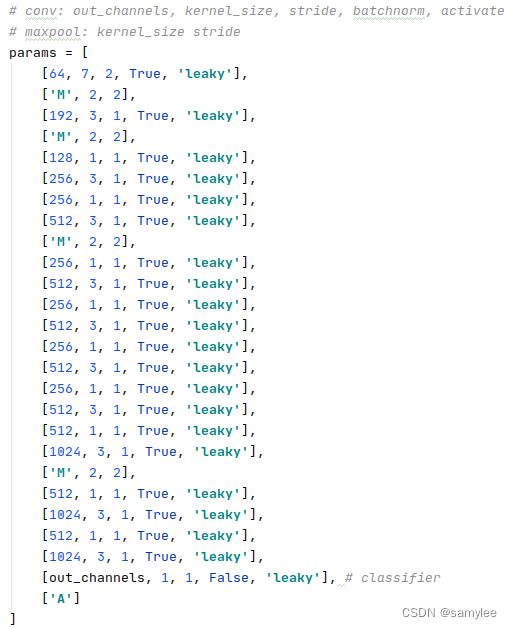YOLO系列解读DAY1—YOLOV1预训练模型
一、说在前面
小伙伴们好,博主很久没有写博客了,略感生疏,不到之处敬请谅解,欢迎指出文中错误,大家一起探讨。欲看视频讲解,可转至博主DouYin、B站,欢迎关注,链接如下:
Github: samylee (samylee) · GitHub
DY: samylee_csdn
B站:samylee
二、写作初衷
YOLO系列详解博客网上很多且质量很高,但大多数都是已文字和图像的形式呈现,未能结合代码做进一步阐述。且yolov1/v2是纯c代码,调试困难,无法直观反映训练和测试过程。所以博主将该代码转到PyTorch下,可一目了然理清Darknet作者的算法思路。话不多说,下面开始!
三、YOLOV1预训练模型
众所周知,在当时预训练模型的性能会直接影响整个检测网络的效果,所以设计出一款好的分类模型是做检测任务的必经之路。分类网络原理部分这里不做进一步阐述了,博主会开设另外系列博客讲解分类网络,敬请期待。
Darknet作者采用自研的extraction网络,在当时已经达到SOTA水平,且速度明显优于同时期SOTA模型,性能如下图所示。
网络设计方面作者采用直到型架构,因当时何恺明等大神尚未提出残差网络,所以直到型还是主流网络架构,如下图所示,其中'M'表示最大池化层,'A'表示平均池化层。
四、Extraction网络转PyTorch
网络转换需要注意三个地方:
1、要求将Extraction网络按照其特定的网络序列复写出PyTorch的网络架构,切不可心浮气躁;
2、Darknet存储参数的序列和PyTorch稍有不同,若遇到BatchNorm架构的卷积层,Darknet会先存储BatchNorm层的参数,进而存储卷积层的参数;
3、图像数据预处理部分,Darknet分类网络的顺序是:BGR2RGB->Norm(1/255)->Resize->Crop,所以我们在复现的时候一定要按照该顺序进行数据预处理操作。
网络复现如下,版本PyTorch1.4,Python3.6,博主暂未加PyTorch的训练代码,因ImageNet训练时间较长,所以直接使用了Extraction的网络模型,若有需要的小伙伴可以评论或私信给博主,博主可添加Extraction分类网络的PyTorch的训练方法。
import torch
import torch.nn as nn
import torch.nn.functional as F
import cv2
import numpy as np
class ExtractionNet(nn.Module):
def __init__(self, in_channels=3, num_classes=1000, init_weights=True, phase='train'):
super(ExtractionNet, self).__init__()
self._phase = phase
self.features = self.make_layers(in_channels=in_channels, out_channels=num_classes)
if init_weights:
self._initialize_weights()
def forward(self, x):
for feature in self.features:
x = feature(x)
if self._phase == 'test':
x = torch.flatten(x, 1)
x = F.softmax(x, dim=-1)
return x
def _initialize_weights(self):
for m in self.modules():
if isinstance(m, nn.Conv2d):
nn.init.kaiming_normal_(m.weight, mode='fan_in', nonlinearity='leaky_relu')
if m.bias is not None:
nn.init.constant_(m.bias, 0)
elif isinstance(m, nn.BatchNorm2d):
nn.init.constant_(m.weight, 1)
nn.init.constant_(m.bias, 0)
elif isinstance(m, nn.Linear):
nn.init.normal_(m.weight, 0, 0.01)
nn.init.constant_(m.bias, 0)
def make_layers(self, in_channels=3, out_channels=1000):
# conv: out_channels, kernel_size, stride, batchnorm, activate
# maxpool: kernel_size stride
params = [
[64, 7, 2, True, 'leaky'],
['M', 2, 2],
[192, 3, 1, True, 'leaky'],
['M', 2, 2],
[128, 1, 1, True, 'leaky'],
[256, 3, 1, True, 'leaky'],
[256, 1, 1, True, 'leaky'],
[512, 3, 1, True, 'leaky'],
['M', 2, 2],
[256, 1, 1, True, 'leaky'],
[512, 3, 1, True, 'leaky'],
[256, 1, 1, True, 'leaky'],
[512, 3, 1, True, 'leaky'],
[256, 1, 1, True, 'leaky'],
[512, 3, 1, True, 'leaky'],
[256, 1, 1, True, 'leaky'],
[512, 3, 1, True, 'leaky'],
[512, 1, 1, True, 'leaky'],
[1024, 3, 1, True, 'leaky'],
['M', 2, 2],
[512, 1, 1, True, 'leaky'],
[1024, 3, 1, True, 'leaky'],
[512, 1, 1, True, 'leaky'],
[1024, 3, 1, True, 'leaky'],
[out_channels, 1, 1, False, 'leaky'], # classifier
['A']
]
module_list = nn.ModuleList()
for i, v in enumerate(params):
modules = nn.Sequential()
if v[0] == 'M':
modules.add_module(f"maxpool_{i}", nn.MaxPool2d(kernel_size=v[1], stride=v[2], padding=int((v[1] - 1) // 2)))
elif v[0] == 'A':
modules.add_module(f"avgpool_{i}", nn.AdaptiveAvgPool2d((1, 1)))
else:
modules.add_module(
f"conv_{i}",
nn.Conv2d(
in_channels,
v[0],
kernel_size=v[1],
stride=v[2],
padding=(v[1] - 1) // 2,
bias=not v[3]
)
)
if v[3]:
modules.add_module(f"bn_{i}", nn.BatchNorm2d(v[0]))
modules.add_module(f"act_{i}", nn.LeakyReLU(0.1) if v[4] == 'leaky' else nn.ReLU())
in_channels = v[0]
module_list.append(modules)
return module_list
def load_darknet_weights(model, weights_path):
# Open the weights file
with open(weights_path, "rb") as f:
# First five are header values
header = np.fromfile(f, dtype=np.int32, count=4)
header_info = header # Needed to write header when saving weights
seen = header[3] # number of images seen during training
weights = np.fromfile(f, dtype=np.float32) # The rest are weights
ptr = 0
for module in model.features:
if isinstance(module[0], nn.Conv2d):
conv_layer = module[0]
if isinstance(module[1], nn.BatchNorm2d):
# Load BN bias, weights, running mean and running variance
bn_layer = module[1]
num_b = bn_layer.bias.numel() # Number of biases
# Bias
bn_b = torch.from_numpy(
weights[ptr: ptr + num_b]).view_as(bn_layer.bias)
bn_layer.bias.data.copy_(bn_b)
ptr += num_b
# Weight
bn_w = torch.from_numpy(
weights[ptr: ptr + num_b]).view_as(bn_layer.weight)
bn_layer.weight.data.copy_(bn_w)
ptr += num_b
# Running Mean
bn_rm = torch.from_numpy(
weights[ptr: ptr + num_b]).view_as(bn_layer.running_mean)
bn_layer.running_mean.data.copy_(bn_rm)
ptr += num_b
# Running Var
bn_rv = torch.from_numpy(
weights[ptr: ptr + num_b]).view_as(bn_layer.running_var)
bn_layer.running_var.data.copy_(bn_rv)
ptr += num_b
else:
# Load conv. bias
num_b = conv_layer.bias.numel()
conv_b = torch.from_numpy(weights[ptr: ptr + num_b]).view_as(conv_layer.bias)
conv_layer.bias.data.copy_(conv_b)
ptr += num_b
# Load conv. weights
num_w = conv_layer.weight.numel()
conv_w = torch.from_numpy(weights[ptr: ptr + num_w]).view_as(conv_layer.weight)
conv_layer.weight.data.copy_(conv_w)
ptr += num_w
if __name__ == '__main__':
# load moel
checkpoint_path = "extraction.weights"
model = ExtractionNet(phase='test')
load_darknet_weights(model, checkpoint_path)
model.eval()
# model input size
net_size = 224
# load img
img = cv2.imread('dog.jpg')
# img bgr2rgb
img_rgb = cv2.cvtColor(img, cv2.COLOR_BGR2RGB)
# resize img
h, w, _ = img_rgb.shape
new_h, new_w = h, w
if w < h:
new_h = (h * net_size) // w
new_w = net_size
else:
new_w = (w * net_size) // h
new_h = net_size
img_resize = cv2.resize(img_rgb, (new_w, new_h))
# crop img
cut_w = (new_w - net_size) // 2
cut_h = (new_h - net_size) // 2
img_crop = img_resize[cut_h:cut_h + net_size, cut_w:cut_w + net_size, :]
# float
img_crop = torch.from_numpy(img_crop.transpose((2, 0, 1)))
img_float = img_crop.float().div(255).unsqueeze(0)
# forward
result = model(img_float)
print(result.topk(5))
五、写在后面
小伙伴们若能坚持完成YOLO系列的代码和原理学习,相信能对图像检测任务有个全新的认识,跟随博主的脚步,培养自己的动手能力吧!希望博主也能坚持将该系列做下去,一起加油!!!
六、参考
1、ImageNet Classification
2、https://github.com/AlexeyAB/darknet

